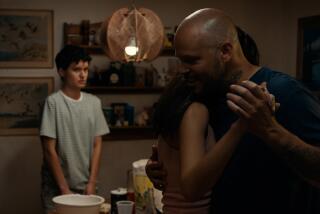MOVIE REVIEW : ‘Heathers’ Gets Lost in a Moral Thicket
“Heathers” (citywide) is about the darker impulses that almost everyone feels at least once during the extended hell week that high school can be: that fleeting urge of “I could just kill him (or her).” In “Heathers” they do.
It’s set in a rich middle-American high school where the ruling clique of Juniors is called the Heathers, after the names of all three members. In training to become a Heather is Veronica (Wynona Ryder), who instead falls under the influence of a dark, disturbing newcomer, J. D. (Christian Slater). Like Veronica, he seems to sneer at the cruelty and consumerism of their classmates, although his methods are hardly usual. First the reigning Heather, Veronica’s oppressor/chum (Kim Walker), is slipped a mug filled with paint stripper; next Veronica lures out, then shoots two obnoxious jock classmates dead in their tracks. It may be disingenuous murder at first, but faced with dead bodies she doesn’t stop; she helps Slater forge notes so that all three are believed to be suicides, touching off suicide mania at Westerburgh High.
“Heathers” is a film that thinks of itself as black comedy; certainly some of the targets in Daniel Waters’ script are overdue for a zinger or two: school cliques, unctuous teachers, parents who won’t be parents and want to be hip post-adolescents, and a society with the values of a television sitcom.
But to mount black comedy successfully, you must have a clearly defined point of view. You must also be willing to follow your dangerous outlook to its most outrageous conclusion, as “A Fish Called Wanda” does when it flattens Kevin Kline with a steamroller. Unfortunately, director Michael Lehmann’s point of view is swivel-mounted: He doesn’t have the courage of his cynicism.
If he did, he’d have to go all the way. Having made treacherous comedy out of the death of innocents--the fact that the innocents are dumb, vicious or loathsome is absolutely beside the point--director Lehmann would have to go out on his self-created limb and saw it off behind him. Having threatened to blow up the high school, “Heathers” would have to end with the biggest explosion of consumers and consumer goods since “Zabriskie Point.”
Then we might take his brackish malice seriously. We might not like it, but it would be easier to respect full-tilt nihilism instead of a director who wimps out with a cloying “After School Special” ending, completely different in tone and style from the film’s other three-quarters.
Having hung out with J. D. until he turns into a real monster, Lehmann has his appealing Veronica turn over a new leaf; she declares herself “the sheriff in the white hat,” new leader of the pack. And to the obese girl who’s been the victim of a particularly humiliating Heathers trick, Veronica suggests chirpily that they sit out the prom together, at home over a video or two. Three deaths are waved away without weight or guilt. They simply don’t count. That is the most profound cynicism of “Heathers.”
The few who remember the interesting, uneven “Static” from two years ago may recall that part of its story turned on a busload of elderly, endearing characters who became hostages in an escalating stand-off with police and finally a SWAT team. In a surprise turn, their bus was blown up. And sitting there stunned, as the dust of the explosion cleared on the horizon, you were forced to confront death as something real.
You might make a case that Veronica is an unwilling accomplice in all this, a pawn to Slater’s drawling J. D., whom she only later sees as a genuine psychopath. But she’s supposed to be the film’s smart kid, lured by J. D.’s philosophy as much as his off-beatness.
Then, too, by having Slater play him in his best Jack Nicholson voice, as a grinning, Nicholson psycho-thug, Lehmann undercuts J. D.’s value as a voice of opposition. Setting sick dangerous anarchy against sick dangerous conformism isn’t much of a choice. When Veronica rejects him at the end, she’s just rejecting craziness, not the flaws in his argument.
Lehmann may not yet demonstrate much heart or even taste; he does have considerable technical skill, and he’s also not above borrowing from the best of the past. (That arresting croquet game shot with Ryder’s head buried in the grass comes from “Repentance” and from Peckinpah and Jodorowsky before that.) And, in addition to his behind-the-camera artists, especially costume designer Rudy Dillon and production designer Jon Hutman, he has been beautifully served by Wynona Ryder, an actress of grace and subtlety since her first moments in “Lucas.” As for Slater, now that we have seen his nifty Nicholson turn twice, can he please go back to his own voice, and mannerisms?
Screenwriter Waters is hardly uninteresting: He knows the turf he’s tearing up, and some of his more scalding moments, the funeral of the two jocks, the college mixer, are dead-on. (In addition to the grisly deaths, “Heathers’ ” R-rating is for the film’s language, which could scrape hulls. Teen-agers may recognize it; it will give timorous adults fits.)
Of course, some may not want to indulge the “Heathers” film makers beyond their first 15 minutes. As Heather No. 1 drains the hull cleaner in one gulp and crashes through her glass-topped table, the idea of using violent death--today--as a jokey grace note may seem so soulless that audiences decamp right there. There’s even another possible alternative. . . .
‘HEATHERS’
A New World Pictures presentation in association with Cinemarque Entertainment (USA) Ltd. Executive producer Christopher Webster. Producer Denise Di Novi. Director Michael Lehmann. Screenplay Daniel Waters. Music David Newman. Editor Norman Hollyn. Camera Francis Kenney. Costumes Rudy Dillon. Production design Jon Hutman. Associate producer Iya Labunka. With Winona Ryder, Christian Slater, Shannen Doherty, Kim Walker, Lisanne Falk, Penelope Milford, Patrick Labyorteaux, Jeremy Applegate, Lance Fenton.
Running time: 1 hour, 42 minutes.
MPAA-rated: R (under 17 requires accompanying parent or adult guardian).
More to Read
Only good movies
Get the Indie Focus newsletter, Mark Olsen's weekly guide to the world of cinema.
You may occasionally receive promotional content from the Los Angeles Times.










